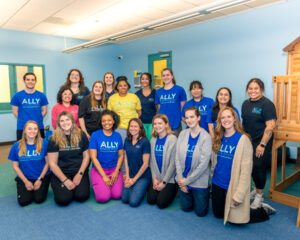What does effective collaboration look like in an ABA therapy center?
Keeping all staff who support the child well-informed should be a top priority. ABA therapy is an evidence-based approach used to help individuals with autism spectrum disorder (ASD) and other developmental disabilities successfully adopt essential skills to reduce challenging behaviors. Having well-informed staff allows for more effective treatment for clients and better communication of progress to families.
Who works in the therapy centers?

Within an ABA therapy center, there are many different professionals working alongside clients and their families. From the initial assessment through the first few weeks at the center, clients and their families will come in contact with several members of a child’s therapy team. Clinical Psychologists, BCBAs (Board Certified Behavior Analysts), RBTs (Registered Behavior Technicians), SLPs (Speech and Language Therapists), and Occupational Therapists are just a few of the professionals who could be working with you and your child.
Typically, each child is accompanied by a trained Registered Behavior Technician (RBT); they are frontline providers of ABA therapy. Most centers will have a 1:1 therapist to child ratio, meaning that all children will have a dedicated staff with them at all times. These therapists work with one child at a time throughout their day to support treatment goals that can range from academic readiness, social skills, communication and daily living skills. RBTs support clients in their treatment plans which are written by the BCBAs and approved by each child’s insurance provider.
Earning the title of BCBA is no easy task. BCBAs are highly trained professionals who always have a masters degree and sometimes even a doctorate! They carefully create, oversee, and modify individualized ABA treatment plans for clients within an ABA therapy center. They typically carry a caseload of clients and support the RBTs in their therapy sessions. Collaboration among BCBAs within the center ensures consistent and evidence-based therapy interventions. It is very common for team members to meet with BCBAs regularly to discuss progress, share observations, review data, offer feedback, and exchange ideas to optimize treatment strategies for their clients.
ABA therapy often goes hand in hand with other therapeutic interventions. Due to this, some centers will offer both speech and occupational therapies within the center to children if recommended by their diagnosing physician. Collaboration with speech therapists and occupational therapists can lead to a more comprehensive and integrated approach to address various developmental needs effectively. If your child is working with a therapist outside of the center, it is important that progress notes and updates are communicated to their ABA team at the center to keep everyone up to speed.
Centers may have an Operations team whose job is to maintain smooth functioning of the therapy center. Here at Ally, our Center Operations team coordinates staff schedules, handles vital administrative paperwork, serves as integral communicators to both parents and staff, conducts parent tours, and leads the final step of enrollment. At a successful center, the center operations team and clinical team will work closely together, creating a supportive environment for both client and staff development.
Encouraging a supportive and positive team culture is vital in an ABA therapy center. Team-building activities, peer support sessions, and open communication channels foster a collaborative environment where everyone feels valued and motivated.
Supporting a family takes teamwork.
Collaboration with the family is vital for a successful ABA therapy treatment plan. Parents and caregivers play a crucial role in reinforcing learned skills outside of therapy sessions. BCBAs must regularly communicate with families, provide progress updates, and offer support and training to promote the generalization of skills to environments outside the center. One of the most important goals of therapy is for skills learned at a center to transfer successfully to other environments. Parents are encouraged to communicate the needs of their children to aid in creating, reviewing, and revising a child’s therapy plan.
Here at Ally
Here at Ally, we follow and practice all of the guidelines and procedures mentioned throughout this article. Our centers are staffed with many different professionals who may have a hand in your child’s individualized treatment plan. Our clinical team works alongside the center operations team to ensure that the therapy center is running efficiently and communication with staff members and parents is at the top of our list of priorities.
Within an Applied Behavior Analysis (ABA) therapy center, collaboration is the most critical component that ensures the best possible outcomes for individuals receiving services. When professionals, caregivers, and stakeholders all work together as a cohesive team, it greatly enhances the child’s progress and quality of life.
For more information about center-based ABA therapy, check out our other article, https://allybehavior.com/resources-research/center-based-benefits/.
Do you have a young child who is showing signs and symptoms of autism? Or, maybe your child is already diagnosed and you believe they need full-time support to prepare for kindergarten and beyond. Ally Behavior Centers may be the right place for your child to begin their therapy journey.
Give us a call at (240) 342-2666 to find out more information, and we’ll be more than happy to answer any questions you have.
[…] Regular Communication: Consistent and transparent communication between parents and ABA professionals is essential. Regular meetings to discuss progress, share observations, review data, and offer feedback help ensure that everyone is aligned on treatment goals and strategies. […]